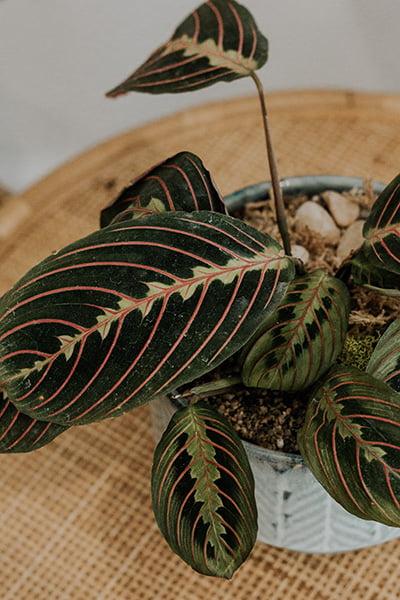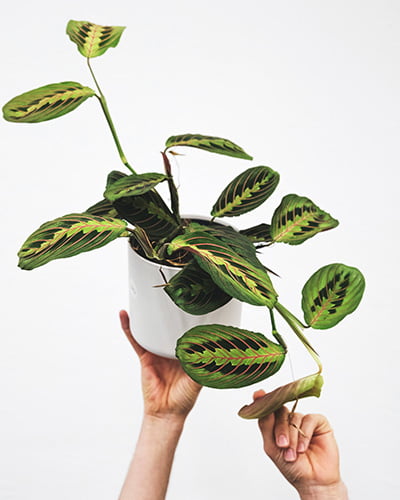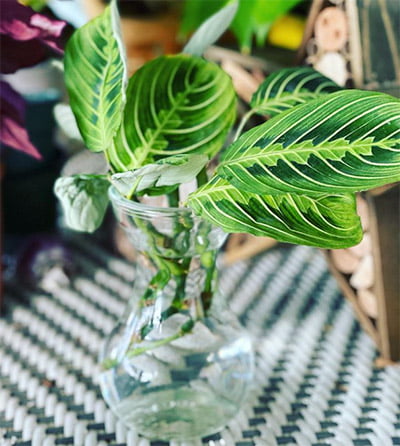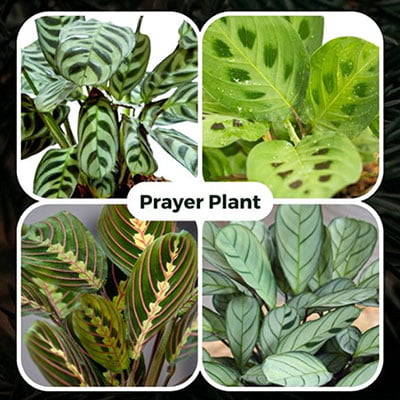If you're looking for an eye-catching plant in your home, look no further than the Prayer Plant. This stunning plant is popular among plant enthusiasts, and for good reasons too. With their lush green leaves and striking patterns, prayer plants are nature's living masterpieces that will make beautiful indoor plants.
Below, we'll share all the information you need to know about taking care of Prayer Plants so that they can thrive in your home. Whether you're a seasoned plant parent or a novice, these magical plants will surely add a touch of beauty and wonder to your space.
Botanical Name
Common Name
Plant Type
Mature Size
Sun Requirement
Soil Type
Humidity
Pet Friendly
Maranta leuconeura
Prayer Plant
Herbaceous, perennial
12-18 in. tall, up to 24 in. wide
Partial, shade
Moist but well-drained
50% to 60%
Yes
What Is A Prayer Plant
Native to the tropical regions of South America, the prayer plant belongs to the Marantaceae family. It is known for its unique characteristic - they close the leaves at night, as if in prayer. Prayer Plant's leaves unfurl and fold as the sun rises and sets, adding a sense of dynamic energy to your home. This makes them not only a unique and attractive addition to your home decor but also a captivating one.
Prayer Plants are more than just pretty plants. They are known for their air-purifying properties, making them the perfect choice for those looking to add a touch of green to their living space while improving indoor air quality. With their low-maintenance nature, they are a great option for both novice plant enthusiasts and busy plant parents.
Prayer Plant Care Requirements
Light
Prayer Plants thrive in bright but indirect light, as their delicate leaves can easily get scorched in direct sunlight. However, this doesn't mean that they should be kept in a dimly lit room - they appreciate a bright and well-lit environment! Placing them near a window facing north or east is ideal, allowing them to soak up the bright yet not overly intense morning sunlight and indirect light for the rest of the day. Too much sun exposure can cause the blotches on their leaves to fade.
Without an ideal spot, you can protect your Prayer Plant from direct sun by using sheer curtains or other shades to filter the light and create a bright, indirect sunlight condition.
And don't worry if you don't have a space with bright indirect light - there are still ways to provide your Prayer Plant with the required light. Supplemental lighting is a great option, especially if you live in a darker climate or have limited windows. LED grow lights are an excellent choice because they offer the ideal spectrum of light for plants to thrive, all while being energy-efficient.
Water
Watering your Prayer Plant might seem simple, but it's a critical part of its growth and health. While they like their soil moist, overwatering can lead to root rot.
Using the bottom-up watering method is an excellent way to ensure that your Prayer Plant receives the right amount of water. All you have to do is fill a shallow tray or bowl with water and place the pot in it. This way, the plant can absorb water through the drainage holes at the bottom of the pot, receiving the optimal amount of hydration. Be sure to drain any excess water from the tray after 30 minutes to avoid root rot.
Another way to give your Prayer Plant the needed water is by misting its leaves. This is especially vital in arid regions or when the air indoors is dry due to heating. Misting can help to keep the leaves moist and healthy, preventing browning or curling.
Soil
Prayer Plants thrive in nutrient-rich, well-draining soil, making it essential to plant them in a pot with a drainage hole so that excess water can flow out adequately. This helps to prevent root rot, which can be deadly to the plant. One excellent option is to use a potting soil mix specially formulated for tropical plants. Such soil mixes usually contain a blend of peat moss, vermiculite, and perlite, providing ample drainage and aeration for the roots. Selecting a soil mix free of pests and diseases is crucial to avoid any issues with your plant down the line.
If you decide to create your own soil mixture, a good recipe for a homemade soil mix for Prayer Plants is equal parts of peat moss, perlite, and a well-balanced organic fertilizer. This soil mix provides the perfect balance of nutrients and drainage for your plant to thrive.
Temperature
Normal household temperatures between 65-80 degrees Fahrenheit will work with Prayer Plants. They're sensitive to cold temperatures and frost, so keeping them in a warm room is important. They also thrive in high humidity, which can be achieved by misting their leaves or using a humidifier.
If your home is prone to temperature fluctuations or you live in a colder climate, you can use a space heater or plant heating mat to keep your Prayer Plant warm. Monitor the temperature carefully and avoid placing the plant near drafts or cold air vents.
It's worth noting that Prayer Plants can be delicate and react to temperature changes. Sudden changes in temperature, such as moving the plant from a warm room to a cooler room, can cause shock and damage the plant. It's best to acclimate your plant gradually by moving it to a cooler room over several days.

Source: Unsplash
Humidity
Prayer Plants are tropical plants that love high humidity and thrive in a humid environment, such as the rainforests of Central and South America, where they are native. They prefer moderate to high humidity levels, ideally between 50% to 60%. Here are some things you can do to achieve the ideal humidity for your Prayer Plant:
Add humidifier
You can use a humidifier or mist its leaves with water. Misting can be done 2-3 times a week or more frequently during dry spells or when the plant is located in a dry environment.
Grouping
One way to boost humidity is to cluster your plants together. As one plant transpires, it releases moisture into the air, increasing the humidity level around the other plants in the group.
Use Pebble Tray
Another effective method is to place a tray of pebbles near the plants to elevate the humidity level.
However, it's important to note that excessive humidity can harm your Prayer Plant's well-being and may encourage fungal growth, leading to root rot and other issues. Therefore, monitoring the humidity levels and making adjustments when needed is crucial to prevent any potential problems.

Source: Unsplash
Fertilization
A balanced fertilizer that contains equal amounts of nitrogen, phosphorus, and potassium is essential for Prayer Plants' optimal growth and health. This type of fertilizer provides the plant with the necessary nutrients it needs to develop strong roots, vibrant foliage, and beautiful blooms. When selecting a fertilizer for your Prayer Plant, be sure to choose a product specifically designed for indoor plants and follow the instructions carefully to avoid over-fertilization, which can harm the plant.
You can also consider using organic fertilizers to provide your Prayer Plant with the nutrients it needs. These types of fertilizers, including compost and worm castings, offer slow-release nutrients that help improve the soil's structure and ability to hold moisture. Organic fertilizers are a great option as they are gentler on the plant and safer for the environment compared to synthetic fertilizers. Be sure to follow the instructions for application and avoid over-fertilizing, which can lead to damage and other problems.
When fertilizing your Prayer Plant, it's crucial to avoid overdoing it. Over-fertilization can cause root burn and harm the plant. It is recommended to fertilize the Prayer Plant once a month during the growing season, usually in early spring and summer. It is best to reduce or stop fertilizing during the dormant season, typically in fall and winter.
Propagation
There are two main ways to propagate a Prayer Plant: division or stem cuttings.
Division
The division is a simple method that involves separating the plant into two or more parts, each with its own roots and leaves. To do this, gently remove the plant from its pot and carefully separate the roots and leaves. Each new section can then be planted in its own pot with fresh soil.
Stem Cuttings

Another method of propagating Prayer Plants is through stem cuttings. This involves taking a stem cutting from the parent plant and planting it in soil or water until it grows roots. This can be a fun and rewarding way to expand your collection or share your plant with others. To do this:
- Select a healthy stem with at least two leaves and cut it just below a leaf node.
- Remove the lower leaves and place the cutting in a jar of water or in soil.
- Keep the soil or water moist and wait for the cutting to grow roots before transferring it to a new pot.
Common Problems
Leaf Curling
One common issue with Prayer Plants is leaf curling. This can be caused by underwatering, low humidity, or exposure to cold drafts. To fix this issue, water your plant regularly, increase the humidity levels around the plant, and avoid placing it near cold air vents or drafts.
Brown leaf tips
If your Prayer Plant shows signs of browning or wilting leaves, it may be over-fertilizing or underwatering. To address this issue, reducing or stopping fertilizing the plant and ensuring it receives adequate water is recommended. Additionally, avoid using tap water containing chemicals such as chlorine, which can harm the plant, and watering with rainwater is recommended.
Yellowing Leaves
There are various reasons why your Prayer Plants leaves may be turning yellow, including overwatering, root rot, or pest infestations. To address this problem, it is recommended to allow the soil to dry out between waterings and ensure the plant is not sitting in stagnant water. If the issue persists, it is important to examine the plant for any signs of pests and consider using a safe insecticide to treat the plant.
Spider Mites
One common pest that can afflict Prayer Plants is spider mites. These tiny pests feed on the plant's sap, leaving behind fine webbing and small yellow or white spots on the leaves. One effective way to combat spider mites is to apply insecticidal soap or a water and neem oil solution mixed. Apply the solution to the affected leaves and stems, covering all the areas where the mites are present.
Mealybugs
These pests look like small, cottony masses on the leaves and stems of the plant. One way to address mealybugs on your plants is to use a cotton swab dipped in rubbing alcohol to remove them manually. Alternatively, you can use insecticidal soap or a mixture of water and neem oil to control the infestation. Apply the solution to the affected areas of the plant to effectively combat mealybugs.
Aphids
Aphids are tiny, soft-bodied insects that feed on plant sap and leave behind a sticky residue on the leaves. To address an aphid infestation, you can use insecticidal soap or a water and neem oil solution. Additionally, spraying the plant with a strong stream of water can help dislodge the insects and reduce their numbers.
Types of Prayer Plants

Maranta leuconeura erythroneura
One of the most popular Prayer Plants varieties, the red prayer plant, features striking green leaves with dark red veins. This unique coloration adds to the plant's visual appeal, making it a popular choice for houseplant enthusiasts.
Maranta leuconeura 'Marisela'
The leaves of the black prayer plant are oval-shaped and feature a striking pattern of green and black. The black coloring is most pronounced at the center of the leaf, while the rest of the leaf is a bright green color. This striking contrast makes the plant a popular choice for those looking for a unique and visually interesting houseplant.
Maranta Fascinator
The leaves of the Maranta Fascinator are oval-shaped, and they feature a stunning feather-like pattern of green, silver, and red veins. Adding to the plant's distinctive appearance, the undersides of its leaves display a deep red color.
Maranta Lemon Lime
If you're looking for something a bit more exotic, the Maranta Lemon Lime is a great choice, with its bright green leaves and yellow veins. The Maranta Kerchoveana, also known as the Rabbit's Foot Prayer Plant, features unique leaves with a fuzzy texture that resembles a rabbit's foot. Finally, the Maranta Red Vein has dark green leaves with vibrant red veins, making for a stunning and dramatic addition to any room.
Maranta Red Vein
The Maranta Red Vein is a stunning type of Prayer Plant with dark green leaves and bright red veins. This plant is an excellent choice for those seeking to bring color and a touch of drama to their home.
Maranta Tricolor
Maranta Tricolor, also known as the herringbone plant, has green leaves with pink and white stripes. This plant is an excellent choice for those seeking a vibrant and colorful addition to their home.
Is Prayer Plant Pet-Friendly?
The good news is that Prayer Plants are generally safe for pets. The leaves of the plant are not toxic to cats or dogs, and they are not known to cause any adverse reactions. However, watching your pets and ensuring they don't ingest the plant is still important.
If you have a curious cat or dog that likes to chew on plants, consider keeping your Prayer Plant out of reach or placing it in a hanging basket. You can also use a spray deterrent, such as bitter apple spray, to discourage your pets from nibbling on the plant.

